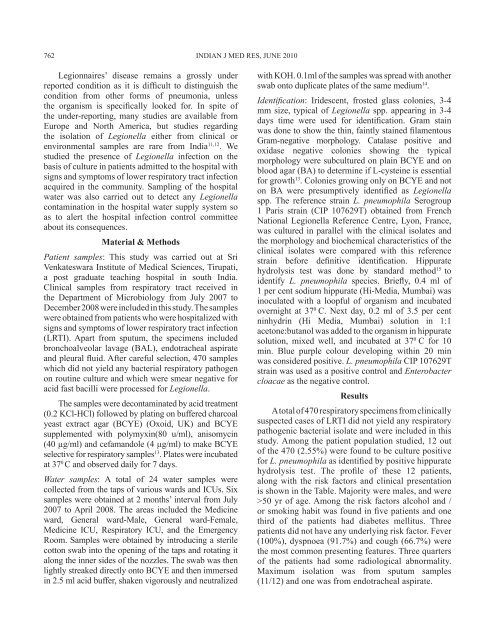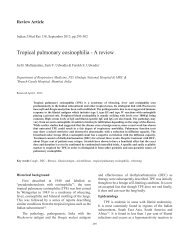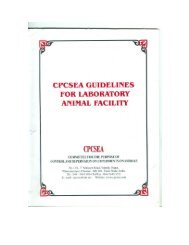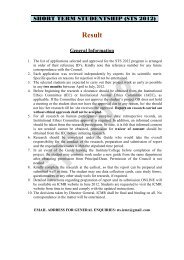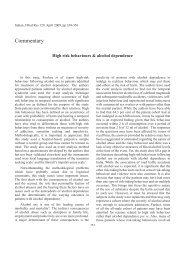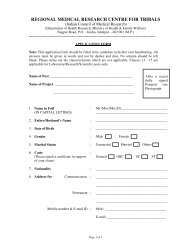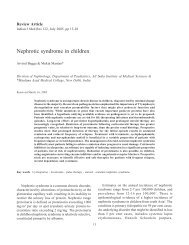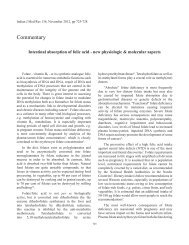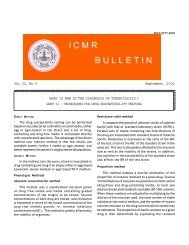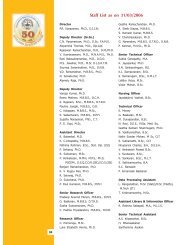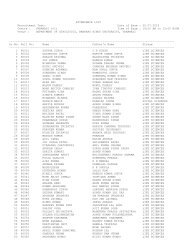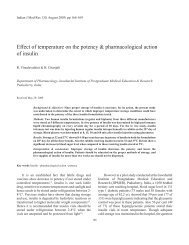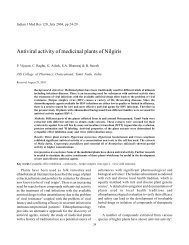Isolation of Legionella pneumophila from clinical & environmental ...
Isolation of Legionella pneumophila from clinical & environmental ...
Isolation of Legionella pneumophila from clinical & environmental ...
You also want an ePaper? Increase the reach of your titles
YUMPU automatically turns print PDFs into web optimized ePapers that Google loves.
762 INDIAN J MED RES, JUNE 2010<br />
Legionnaires’ disease remains a grossly under<br />
reported condition as it is difficult to distinguish the<br />
condition <strong>from</strong> other forms <strong>of</strong> pneumonia, unless<br />
the organism is specifically looked for. In spite <strong>of</strong><br />
the under-reporting, many studies are available <strong>from</strong><br />
Europe and North America, but studies regarding<br />
the isolation <strong>of</strong> <strong>Legionella</strong> either <strong>from</strong> <strong>clinical</strong> or<br />
<strong>environmental</strong> samples are rare <strong>from</strong> India 11,12 . We<br />
studied the presence <strong>of</strong> <strong>Legionella</strong> infection on the<br />
basis <strong>of</strong> culture in patients admitted to the hospital with<br />
signs and symptoms <strong>of</strong> lower respiratory tract infection<br />
acquired in the community. Sampling <strong>of</strong> the hospital<br />
water was also carried out to detect any <strong>Legionella</strong><br />
contamination in the hospital water supply system so<br />
as to alert the hospital infection control committee<br />
about its consequences.<br />
Material & Methods<br />
Patient samples: This study was carried out at Sri<br />
Venkateswara Institute <strong>of</strong> Medical Sciences, Tirupati,<br />
a post graduate teaching hospital in south India.<br />
Clinical samples <strong>from</strong> respiratory tract received in<br />
the Department <strong>of</strong> Microbiology <strong>from</strong> July 2007 to<br />
December 2008 were included in this study. The samples<br />
were obtained <strong>from</strong> patients who were hospitalized with<br />
signs and symptoms <strong>of</strong> lower respiratory tract infection<br />
(LRTI). Apart <strong>from</strong> sputum, the specimens included<br />
bronchoalveolar lavage (BAL), endotracheal aspirate<br />
and pleural fluid. After careful selection, 470 samples<br />
which did not yield any bacterial respiratory pathogen<br />
on routine culture and which were smear negative for<br />
acid fast bacilli were processed for <strong>Legionella</strong>.<br />
The samples were decontaminated by acid treatment<br />
(0.2 KCl-HCl) followed by plating on buffered charcoal<br />
yeast extract agar (BCYE) (Oxoid, UK) and BCYE<br />
supplemented with polymyxin(80 u/ml), anisomycin<br />
(40 µg/ml) and cefamandole (4 µg/ml) to make BCYE<br />
selective for respiratory samples 13 . Plates were incubated<br />
at 37 0 C and observed daily for 7 days.<br />
Water samples: A total <strong>of</strong> 24 water samples were<br />
collected <strong>from</strong> the taps <strong>of</strong> various wards and ICUs. Six<br />
samples were obtained at 2 months’ interval <strong>from</strong> July<br />
2007 to April 2008. The areas included the Medicine<br />
ward, General ward-Male, General ward-Female,<br />
Medicine ICU, Respiratory ICU, and the Emergency<br />
Room. Samples were obtained by introducing a sterile<br />
cotton swab into the opening <strong>of</strong> the taps and rotating it<br />
along the inner sides <strong>of</strong> the nozzles. The swab was then<br />
lightly streaked directly onto BCYE and then immersed<br />
in 2.5 ml acid buffer, shaken vigorously and neutralized<br />
with KOH. 0.1ml <strong>of</strong> the samples was spread with another<br />
swab onto duplicate plates <strong>of</strong> the same medium 14 .<br />
Identification: Iridescent, frosted glass colonies, 3-4<br />
mm size, typical <strong>of</strong> <strong>Legionella</strong> spp. appearing in 3-4<br />
days time were used for identification. Gram stain<br />
was done to show the thin, faintly stained filamentous<br />
Gram-negative morphology. Catalase positive and<br />
oxidase negative colonies showing the typical<br />
morphology were subcultured on plain BCYE and on<br />
blood agar (BA) to determine if L-cysteine is essential<br />
for growth 13 . Colonies growing only on BCYE and not<br />
on BA were presumptively identified as <strong>Legionella</strong><br />
spp. The reference strain L. <strong>pneumophila</strong> Serogroup<br />
1 Paris strain (CIP 107629T) obtained <strong>from</strong> French<br />
National <strong>Legionella</strong> Reference Centre, Lyon, France,<br />
was cultured in parallel with the <strong>clinical</strong> isolates and<br />
the morphology and biochemical characteristics <strong>of</strong> the<br />
<strong>clinical</strong> isolates were compared with this reference<br />
strain before definitive identification. Hippurate<br />
hydrolysis test was done by standard method 15 to<br />
identify L. <strong>pneumophila</strong> species. Briefly, 0.4 ml <strong>of</strong><br />
1 per cent sodium hippurate (Hi-Media, Mumbai) was<br />
inoculated with a loopful <strong>of</strong> organism and incubated<br />
overnight at 37 0 C. Next day, 0.2 ml <strong>of</strong> 3.5 per cent<br />
ninhydrin (Hi Media, Mumbai) solution in 1:1<br />
acetone:butanol was added to the organism in hippurate<br />
solution, mixed well, and incubated at 37 0 C for 10<br />
min. Blue purple colour developing within 20 min<br />
was considered positive. L. <strong>pneumophila</strong> CIP 107629T<br />
strain was used as a positive control and Enterobacter<br />
cloacae as the negative control.<br />
Results<br />
A total <strong>of</strong> 470 respiratory specimens <strong>from</strong> <strong>clinical</strong>ly<br />
suspected cases <strong>of</strong> LRTI did not yield any respiratory<br />
pathogenic bacterial isolate and were included in this<br />
study. Among the patient population studied, 12 out<br />
<strong>of</strong> the 470 (2.55%) were found to be culture positive<br />
for L. <strong>pneumophila</strong> as identified by positive hippurate<br />
hydrolysis test. The pr<strong>of</strong>ile <strong>of</strong> these 12 patients,<br />
along with the risk factors and <strong>clinical</strong> presentation<br />
is shown in the Table. Majority were males, and were<br />
>50 yr <strong>of</strong> age. Among the risk factors alcohol and /<br />
or smoking habit was found in five patients and one<br />
third <strong>of</strong> the patients had diabetes mellitus. Three<br />
patients did not have any underlying risk factor. Fever<br />
(100%), dyspnoea (91.7%) and cough (66.7%) were<br />
the most common presenting features. Three quarters<br />
<strong>of</strong> the patients had some radiological abnormality.<br />
Maximum isolation was <strong>from</strong> sputum samples<br />
(11/12) and one was <strong>from</strong> endotracheal aspirate.


